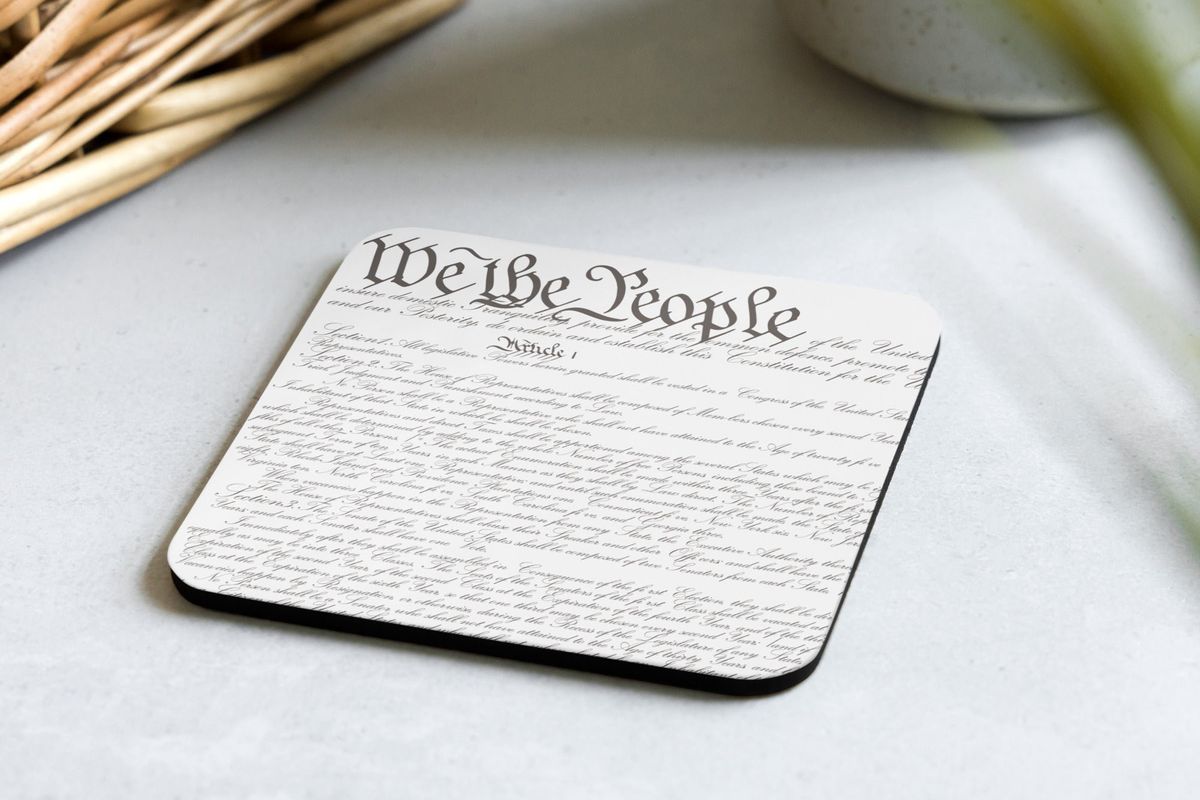America's Silence Is Not Compliance (And Here Is How We Prove It)
After watching the inauguration, and listening to President Donald J. Trump’s weird, ramble-y, post-speech event in Emancipation Hall afterwards, I am oddly less worried than I have been since the election.
Perhaps it was the funny stuff. For example, Melania’s odd hat. It covered half of her face, allowing her to sleep sitting up if she chose to and, as The Daily Showpointed out,almost exactly matched the Pizza Hut logo. Others compared it to Spy vs. Spy from Mad Magazine, and to McDonald’s Hamburgler.
Or perhaps it was Joe Biden, who cracked his old, familiar “can you believe this shit?” smile at some of Trump’ old, familiar lies and boasts.
Then, there was country star Carrie Underwood, who ended the long awkward pause as someone was unable to start the music, said a silent “fuck it,” and sang “America the Beautiful” a cappella. If only she had followed that song up with “Before He Cheats.”
You have to wonder: if the Trump people can’t get the music started at their kick-off event, what else can’t they do?
We will soon find out. Will everything in the new Trump administration run like the switch watch we have been warned about, or will it be as—or more—dysfunctional than the last time? Will the policy agenda, in the end, be bigger or smaller, as befits an already-lame duck guy? Will President Donald J. Trump—who promises bigger—be more empowered because he has a better-organized executive team and faces little opposition in his own party? Or will he shed members of the executive branch at the same rate as in his first term (news flash: Vivek is already gone.)
Another unknown: will the institutions that are designed to stop Trump and his MAGA thugs be better able to do it because they have had time to prepare, because Trump has telegraphed everything he plans to do, and these well-funded groups have legal teams standing ready to stop, or at least slow, him in the courts?
I suspect that the next two to four years (depending on whether the Democrats can flip the House or the Senate in 2026) will both be worse than what we went through between 2017 and 2021, and better in ways we can’t know yet. Perhaps this, and not apathy or depression, accounts for the virtual silence from the 50.1 percent of voters who did not cast their ballots for Donald Trump.
But silence is not compliance, which is why I bristled yesterday when I read Peter Baker’s column in The New York Times, in which he equated the absence of street-level protest and outrage to popular acquiescence in the coming weeks and months. Observing the contrast between the elaborate security measures taken around the Capitol and the lack of activists to defend against, Baker writes that “if Washington looks like a war zone again, it does not necessarily feel that way. Unlike the last time President-elect Donald J. Trump took the oath of office eight years ago,” he continues, “the bristling tension and angry defiance have given way to accommodation and submission. The Resistance of 2017 has faded into the Resignation of 2025.”
It gets worse. “Much of the world, it seems, is bowing down to the incoming president,” Baker writes:
Technology moguls have rushed to Mar-a-Lago to pay homage. Billionaires are signing seven-figure checks and jockeying for space at the inaugural ceremony. Some corporations are pre-emptively dropping climate and diversity programs to curry favor.
Some Democrats are talking about working with the newly restored Republican president on discrete issues. Some news organizations are perceived to be reorienting to show more deference. The grass roots opposition that put hundreds of thousands of people in the streets of Washington to protest Mr. Trump just a day after he was sworn in back in 2017 generated a fraction of that in their sequel on Saturday.
“Hashtag-resistance has turned into hashtag-capitulation,” MAGA strategist David Urban told Baker. “The pink-pussy hats are gone, and they’re replaced by MAGA hats worn by Black and brown people.”
Bullshit. Nothing is gone, no one has capitulated, and Trump’s base is still majority white. The resistance is waiting, we are rebuilding, and we are trying to do it better next time. Instead of spending our days unspooling as the ideas and values cherished by liberals and the left disappear from the stage in Washington, we are trying to figure out why what we did didn’t work, and learn how to fight differently and better.
And this is where you, dear readers, may want to start.
Identify vulnerable people, help them, and stand up to anyone who bullies them.
The policies Trump says he will pursue in the next four years will not just withdraw protections from social minorities and women, but also many of the middle-class and poor people who voted for him. Tax policies will be presented as putting money in ordinary Americans’ pockets, even as other policies are quietly picking those same pockets.
So, there is no doubt that people will be hurt. Give them money. Help them get to where they need to go for an abortion, to get transgender care, to get away from an abuser—or from ICE. If you are a lawyer, set aside some (or more) of your time for pro bono actions. Don’t throw electronics, clothes, furniture, and other useful items away: instead, join the Buy Nothing Facebook in your area and give them to people who need them.
Leak: if you have factual information about a raid, or an action, that promotes an unjust use of state power, tell a local reporter. Already, it looks like the leaked plans for ICE raids in Chicago this week have caused that action to be postponed.
Most of all, as MAGA policies normalize abusive behavior, stand up to it. Say no to cruelty and stupidity. Say no to violent behavior and language. Get between abusers and the abused. Teach your children that only weak, angry people hurt others who are less powerful, and give them common-sense strategies to stand up to bullies.
Don’t let elections go by without volunteeringand never miss an opportunity to cast your vote.
It’s not enough to give money. The billions of dollars sloshing around our electoral system have only produced more polarization and paralysis. People know less about what is at stake in an election than they ever did. We now know that an unprecedented outpouring of energy, donations, and volunteering that greeted Kamala Harris’s candidacy was not enough to avert a second Trump presidency.
Imagine going local and rebuilding the Democratic Party from the grassroots up. What if this kind of organizing, and the conversations between friends and neighbor it incites, did not just happen every four years—and was not just focused on the Presidency and other higher offices? The conservative 1776 Project, which has been working to flip school boards across the nation to MAGA policies for the last four years, demonstrates that a well-chosen candidate and just a few thousand dollars for pamphlets and signs can win a local election.
For a starter pack on how to run for office, and access to resources and training, check out Run for Something. But you don’t need a national organization to help you do this. All you need is your local Democratic committee: go here for your state party website, which will lead you to those of your neighbors who are already doing the work.
Screen out the noise and seek out information. Stop relying on social media and cable TV for news.
Anyone who follows me knows that I am very engaged on social media, and how devoted I am to this Substack. But it has limits: what you don;t know is how much time I spend reading actual books, magazines, newspapers, and political research. Social media and cable television have blurred the distinction between reported journalism and opinion writing. Everyone needs reported journalism run order to understand what is going on in politics and respond to it with words or action.
I know many people don’t trust major newspapers anymore but pick one (or two) and read the reported stories about politics. Jeff Bezos or no Jeff Bezos, I think The Washington Post still delivers the best reporting on national government; the Wall Street Journal on foreign policy and economics; and The New York Times has a team led out by Maggie Haberman that will be critical to reporting what is going on in the White House.
Other sources I cherish: ProPublica and the PBS NewsHour (which you can see on YouTube any time after it is broadcast.)
And here’s something you can do to change the future: if you have kids, get them accustomed to reading the newspaper too. Watch the NewsHour with them—or even just a segment from it—and discuss the news informally by asking them what they think.
Here’s the thing: kids who get their news on TikTok and Instagram become adults who get their news on TikTok and citizens who vote for people they don’t know anything about.
Support local media.
Do you have a local newspaper? Subscribe to it, and while you are at it, write for it. Ask the editor if they would accept reports on local politics from freelance you. If you have a business, advertise in it. If you have no local paper anymore, start one on WordPress or Substack.
Local media is the heart and soul of democracy, and is traditionally one of our most trusted sources. If our local and regional news outlets had not been gutted, we would better understand how national events affect our local communities.
Pay attention to local K-12 education and library systems; defend and improve them.
We managed to get through an entire Presidential election in which neither political party had anything to say about education. At all. Yet, conservative activists powered much of the culture wars from school board meetings, beginning in 2021. And liberal parents are up in arms about pandemic policies and the harm they believe has been derived from them—yet there is virtually no public conversation about what we want our education systems to be and do. Librarians in three dozen states are fighting a rearguard action against censorship, with virtually no pushback from citizens.
And for God’s sake, when you know what is being cut from your kid’s education, pick up the slack and teach that to them yourself.
So that’s all for now. Fasten your seatbelts friends: it’s going to be a bumpy four years, but we will go through it together.
Reprinted with permission from Political Junkie










